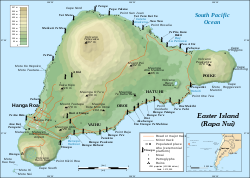Easter Island
| |
|---|---|
 Outer slope of the Rano Raraku volcano, the quarry of the Moais with many uncompleted statues. | |
|
| |
 | |
| Coordinates: 27°07′S 109°21′W / 27.12°S 109.35°W | |
| Country | Chile |
| Region | Valparaíso |
| Province | Isla de Pascua |
| Commune | Isla de Pascua |
| Seat | Hanga Roa |
| Government | |
| • Type | Municipality |
| • Body | Municipal council |
| • Provincial Governor | René De la Puente Hey (IND) |
| • Alcalde | Pedro Edmunds Paoa (PRO) |
| Area | |
• Total | 163.6 km2 (63.2 sq mi) |
| Highest elevation | 507 m (1,663 ft) |
| Lowest elevation | 0 m (0 ft) |
| Population (2017 census) | |
• Total | 7,750[1] |
| • Density | 47/km2 (120/sq mi) |
| Time zone | UTC−6 (EAST) |
| • Summer (DST) | UTC−5 (EASST) |
| Country Code | +56 |
| Currency | Peso (CLP) |
| Language | Spanish, Rapa Nui |
| Driving side | right |
| Website | dppisladepascua |
| NGA UFI=-905269 | |
| UNESCO World Heritage Site | |
|---|---|
 Moai at Rano Raraku, Easter Island | |
| Criteria | Cultural: i, iii, v |
| Reference | 715 |
| Inscription | 1995 (19th Session) |
| Area | 71.3 km2 (27.5 sq mi) |
Easter Island (Spanish: Isla de Pascua, [ˈisla ðe ˈpaskwa]; Rapa Nui: Rapa Nui, [ˈɾapa ˈnu.i]) is an island and special territory of Chile in the southeastern Pacific Ocean, at the southeasternmost point of the Polynesian Triangle in Oceania. The island is renowned for its nearly 1,000 extant monumental statues, called moai, which were created by the early Rapa Nui people. In 1995, UNESCO named Easter Island a World Heritage Site, with much of the island protected within Rapa Nui National Park.
Experts differ on when the island's Polynesian inhabitants first reached the island. While many in the research community cited evidence that they arrived around the year 800, a 2007 study provided compelling evidence suggesting their arrival was closer to 1200.[3][4] The inhabitants created a thriving and industrious culture, as evidenced by the island's numerous enormous stone moai and other artifacts. But land clearing for cultivation and the introduction of the Polynesian rat led to gradual deforestation.[3] By the time of European arrival in 1722, the island's population was estimated to be 2,000 to 3,000. European diseases, Peruvian slave raiding expeditions in the 1860s, and emigration to other islands such as Tahiti further depleted the population, reducing it to a low of 111 native inhabitants in 1877.[5]
Chile annexed Easter Island in 1888. In 1966, the Rapa Nui were granted Chilean citizenship. In 2007 the island gained the constitutional status of "special territory" (Spanish: territorio especial). Administratively, it belongs to the Valparaíso Region, constituting a single commune (Isla de Pascua) of the Province of Isla de Pascua.[6] The 2017 Chilean census registered 7,750 people on the island, of which 3,512 (45%) identified as Rapa Nui.[7]
Easter Island is one of the world's most remote inhabited islands.[8] The nearest inhabited land (around 50 residents in 2013) is Pitcairn Island, 2,075 kilometres (1,289 mi) away;[9] the nearest town with a population over 500 is Rikitea, on the island of Mangareva, 2,606 km (1,619 mi) away; the nearest continental point lies in central Chile, 3,512 km (2,182 mi) away.
- ^ "Censo 2017". National Statistics Institute (in Spanish). Archived from the original on 11 May 2018. Retrieved 11 May 2018.
- ^ a b "Censo de Población y Vivienda 2002". National Statistics Institute. Archived from the original on 15 July 2010. Retrieved 1 May 2010.
- ^ a b Cite error: The named reference
terry_huntwas invoked but never defined (see the help page). - ^ Dangerfield, Whitney (31 March 2007). "The Mystery of Easter Island". Smithsonian Magazine. Archived from the original on 1 May 2022. Retrieved 10 December 2020.
- ^ Peiser, B. (2005). "From Genocide to Ecocide: The Rape of Rapa Nui" (PDF). Energy & Environment. 16 (3&4): 513–539. Bibcode:2005EnEnv..16..513P. CiteSeerX 10.1.1.611.1103. doi:10.1260/0958305054672385. ISSN 0958-305X. S2CID 155079232. Archived from the original (PDF) on 10 June 2010.
- ^ List of Chilean Provinces, Congreso Nacional, archived from the original on 10 September 2012, retrieved 20 February 2013
- ^ "Instituto Nacional de Estadísticas – REDATAM Procesamiento y diseminación". Redatam-ine.ine.cl. Archived from the original on 27 May 2019. Retrieved 11 January 2019.
- ^ "Welcome to Rapa Nui – Isla de Pascua – Easter Island", Portal RapaNui, the island's official website, archived from the original on 14 January 2012
- ^ Thomas Brinkhoff (1 February 2013). "Pitcairn Islands". Citypopulation.de. Thomas Brinkhoff. Archived from the original on 15 October 2013. Retrieved 8 November 2013.



